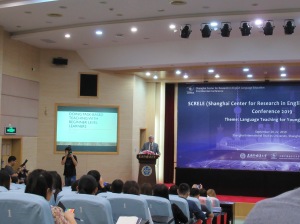At the end of September, I attended the Shanghai Center for Research in English Language Education (SCRELE) Conference on Language Teaching for Young Learners.

The conference started with a day of workshops for local teachers and students. The morning session I attended was ran by Annamaria Pinter from the University of Warwick, UK. Her session was called ‘Listening to Children’s Voices’ and she spoke about the importance of engaging children in their learning, motivating them and giving them ownership of their studies, and the different ways in which teachers might do this. We participated in several classroom activities, such as questioning Annamaria about the items in her handbag and seeing how many English words we could make out of the letters in the word ‘chocolate’. I was beaten in this task by the Swedish attendee next to me!
During the afternoon session, I attended Jonathan Newton’s workshop on creativity in classroom language teaching. This was also an interactive session during which we discussed the different ways in which teachers can engage learners. This included thinking up unusual ways in which teachers might start a class or do the unexpected. I left the session enthused and inspired with all sorts of ideas…only to remember that I am not a teacher and won’t be putting these ideas into practice!

Then, as the pouring rain began, so did the main conference. But we were not concerned, as we were told that in China rain at the start of an event is a good omen as it means that the event will run as smoothly as the rain! And that was true…the conference did run smoothly and was an interesting few days, filled full of talks on the topic of teaching languages to young learners. The conference organisers had invited an impressive array of keynote speakers: Rod Ellis, Maria Pilar Garcia Mayo, Anna-Maria Pinter, Xiaotang Cheng, Yafu Gong and Jonathan Newton, as well as two colloquia organised by Janet Enever and Yuko Goto Butler, and several sessions of papers.

During my time in Shanghai I was also able to squeeze in lunch with my long-standing contact, Huachu Liu and his colleague Angel, of the Shanghai Foreign Language Education Press. We have worked together with SFLEP over many years to enable some of our books to be available in local editions (at local prices) for Chinese readers. It was great to finally see where they are based and to enjoy chatting over a delicious lunch of local specialties.
All in all, it was a great trip to Shanghai, despite the pouring rain!



















